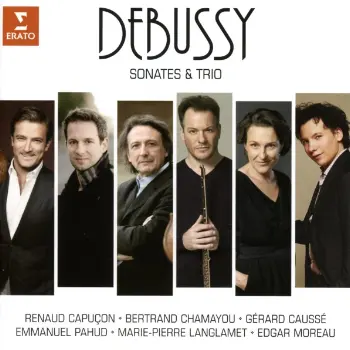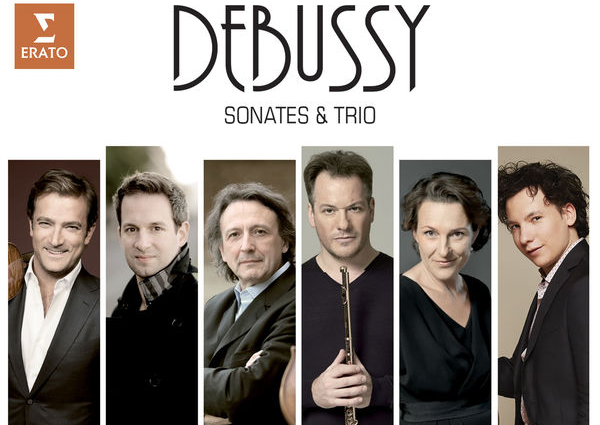This is something special. Debussy intended to write a cycle of 6 Sonatas for diverse instruments, with the last Sonata being a “Concerto” for all the participating instruments. Unfortunately, he didn’t accomplish this fascinating experiment, but left us with chamber masterpieces that can stand their own.

Check offers of this album on Amazon.
An all-star performance, it includes some of France’s most outstanding musicians. In the Cello and Violin Sonatas, the wonderful pianist Bertrand Chamayou continues his journey through French romanticism and impressionism, after his well-received recording of Maurice Ravel’s complete piano music, along with an outstanding album of solo and concertante works by César Franck. Here he once again exemplifies the ideal chamber musician — Acute listening, subtle accompaniment and with well colored solo passages. Merging with other musicians without losing his own singularity.
What is very striking when listening to this recording is how there are no flashy, virtuosic gestures in the music, unless specifically called for in the score. The Cello Sonata receives a dark, animated performance. The very difficult Cello part is performed flawlessly by the young Edgar Moreau. Just listen to the great pizzicato exchange with the piano in the “Sérénade” movement. Less melodically “catchy” then the Violin Sonata, it’s fascinating from start to finish, like the rest of the album.
The Violin Sonata, performed here by Violinist Renaud Capuçon, can be seemed as a new benchmark recording for this often-recorded piece. As mentioned, it may be less flashy or worm toned than other benchmark performances from the past — Namely Chung-Lupu and Dumay-Pires. But it seems the most appropriate to the music. Capuçon uses less vibrato and in some passages seems to “think aloud” where to go next in the music (First movement, “2:50 is a good example). Other violinists will take the romantic second theme with pronounced excitement, but Capuçon keeps it cool, allowing the music to catch the ear without superficial effects.
imaginative Highlight
But the highlight of this album is the imaginative Sonata for Flute, Viola and Harp. Here again, this recording can be compared to a classic recording by the Melos Ensemble some 30 years ago, available together with the Chung-Lupu recording of the violin sonata. The Melos recording stood out for its simplicity, where this new recording can be seen as more complex. This is also due to the recording quality, which is top notch and allows a much bigger dynamic range than the old Decca recording. The great Emmanuel Pahud, principal flutist of the Berlin Philharmonic, blends beautifully with the harp and Viola — Listen for example to the subtle entrance of the flute and harp in response to the viola solo, at “3:30 in the first movement. This is only one out of numerous magical moment in this sonata.
A much early piece, the sunny and cheerful Piano Trio receives a masterful performance by Chamayou, Capuçon and Moreau. It’s hard to think of a better suited trio of musicians, where everything is spontaneous and perfectly balanced. Listen to the Scherzo and try not to smile. Sample the trio from this recording here:
This is one of the most impressive chamber recordings of the past year and should be listened to, with pleasure again and again. You would be surprised how much you’d find in it in re-listening.

Debussy — Cello Sonata(1), Violin Sonata(2), Flute, Viola and Harp Sonata(3), Syrinx (4), Piano Trio (5)
Bertrand Chamayou (1,2,5), Edgar Moreau (1), Renaud Capuçon (2), Gérard Caussé, Emmanuel Pahud, Marie-Pierre Langlamet (3)
Warner Classics, CD 0190295773960

Check offers of this album on Amazon.
Album Details |
|
|---|---|
| Album name | Debussy – Chamber Music |
| Label | Erato / Warner Classics |
| Amazon Music link | Stream here |
| Apple Music link | Stream here |

















